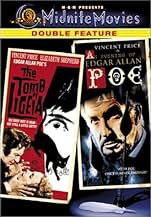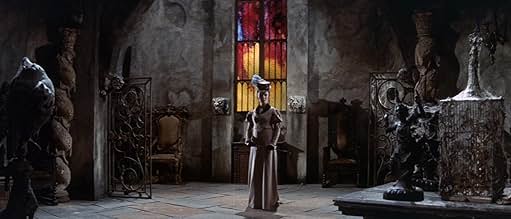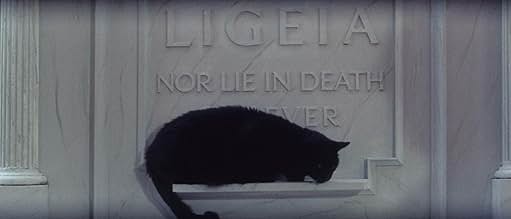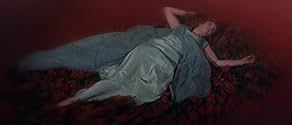AVALIAÇÃO DA IMDb
6,4/10
7,2 mil
SUA AVALIAÇÃO
A obsessão de um homem por sua esposa morta cria uma distância entre ele e sua nova noiva.A obsessão de um homem por sua esposa morta cria uma distância entre ele e sua nova noiva.A obsessão de um homem por sua esposa morta cria uma distância entre ele e sua nova noiva.
- Direção
- Roteiristas
- Artistas
Maxwell Craig
- Wedding Guest
- (não creditado)
Anthony Lang
- Wedding Guest
- (não creditado)
Del Watson
- Footman
- (não creditado)
Fred Wood
- Wedding Guest
- (não creditado)
- Direção
- Roteiristas
- Elenco e equipe completos
- Produção, bilheteria e muito mais no IMDbPro
Avaliações em destaque
Well, at least for a little while! His last of eight Poe films as director is (loosely) based on the Poe work of the same name and is a solid metaphorical ghost story. Lady Rowena (the wonderful Elizabeth Shepherd) falls in love with Verden Fell (Vincent Price) despite his strange behavior and questionable past. Soon after their marriage, he starts disappearing, she's menaced by that old Poe stand-by (the evil black cat) and plagued by horrific nightmares involving Verden's deceased former wife Ligeia (also played by Shepherd), whose ghost seems intent on ruining the union. Price, in top hat and strange sunglasses in many scenes (his vision being "dangerously acute"), seems a bit too old for the role, but still manages to come through with an effective performance. Corman has always been underrated for effectively capturing period detail on a limited budget and it's his keen eye for the crumbling ruins, lush green countrysides, oceanfronts and shadowy castle corridors that make much of this film work. Screenplay by future Oscar-winner Robert Towne (CHINATOWN). LIGEIA was Corman's last horror film as director until 1990's FRANKENSTEIN UNBOUND.
I was asked recently if I could name any genuinely scary films made before The Exorcist in 1973. The only titles I could come up with were Rosemary's Baby and Night of the Living Dead from the late '60s. I could suggest many horror titles made before 1970, but none were genuinely flesh-crawling enough to make the list. At the time, I had not seen The Tomb of Ligeia. Now I have seen it and, wow! This is one seriously under-rated gem.
It is one of the many Roger Corman films from this era based on an Edgar Allan Poe story. Intelligently scripted by Robert Towne, and acted to perfection by Vincent Price and Elisabeth Shepherd, this film is a treat from start to finish. Shepherd plays a well-to-do lady in Victorian England who falls in love with a mysterious loner (Price) who resides in a crumbling abbey and seems haunted by memories of his previous (now-dead) wife Ligeia. She marries Price, but her chances of love are blighted by spooky happenings which may be the work of the ghost of his jealous ex-bride.
The dream sequence, featuring a dead fox hidden in a bouquet of flowers and a terrifying metamorphosis midway through a passionate kiss, is a marvellous and memorable scene. All scenes featuring the weird black cat are eerily effective. There's also a wonderfully creepy hypnotism episode. The photography is lovely, with colourful outdoor lensing of a real English abbey and superb blending of light and shadows during the ghostly indoor sequences.
So, if you're after a truly spine-tingling film from before 1970 - here you go!
It is one of the many Roger Corman films from this era based on an Edgar Allan Poe story. Intelligently scripted by Robert Towne, and acted to perfection by Vincent Price and Elisabeth Shepherd, this film is a treat from start to finish. Shepherd plays a well-to-do lady in Victorian England who falls in love with a mysterious loner (Price) who resides in a crumbling abbey and seems haunted by memories of his previous (now-dead) wife Ligeia. She marries Price, but her chances of love are blighted by spooky happenings which may be the work of the ghost of his jealous ex-bride.
The dream sequence, featuring a dead fox hidden in a bouquet of flowers and a terrifying metamorphosis midway through a passionate kiss, is a marvellous and memorable scene. All scenes featuring the weird black cat are eerily effective. There's also a wonderfully creepy hypnotism episode. The photography is lovely, with colourful outdoor lensing of a real English abbey and superb blending of light and shadows during the ghostly indoor sequences.
So, if you're after a truly spine-tingling film from before 1970 - here you go!
"The Tomb of Ligeia" was one of a cycle of films made by Roger Corman in the sixties based on the works of Edgar Allen Poe. Verden Fell, an English country gentleman of the 1820s has become obsessed with his dead wife Ligeia. Indeed, although she has been buried in a tomb he built for her, he believes that she is not dead but has, as she promised she would, survived death in some form and will return to him. This obsession survives Fell's remarriage to Rowena, the daughter of a neighbouring landowner. Indeed, his obsession worsens, as he comes to believe that Rowena is possessed by Ligeia's spirit.
This is an unusual horror film in that much of it takes place not only outdoors but also in daylight. The sort of images of ruin and decay traditional in horror films- Fell lives in a gloomy, crumbling, cobwebbed manor house close to the ruins of a mediaeval abbey- are contrasted with sunlit scenes of the beautiful, verdant English countryside. The difference between life and death is the central idea of the film- which ends with a quote from Poe himself: "The boundaries which divide life from death are at best shadowy and vague. Who shall say where the one ends and where the other begins"- so this contrast is possibly symbolic, with the outdoor scenes symbolising life and the indoor ones death. The two main female characters (both played by the same actress, Elizabeth Shepherd) are differentiated in a similar manner. Rowena is a healthy-looking, "English Rose" type blonde with a love of outdoor pursuits, especially hunting. Ligeia is dark haired and gaunt with an unhealthy pallor.
Like many films of this period, and unlike later films such as "The Exorcist", this is an example of an understated horror film, with the horror mostly being implied rather than shown directly. Ligeia makes an appearance in the film, but we are never sure whether this is really her ghost returning from the grave or a hallucination conjured up by Fell's distraught mind. Although it is understated, however, it is genuinely frightening, not because of Exorcist-style special effects, but because of the eerie mood that Corman is able to create. Apart from the atmospheric setting, various objects take on a sinister significance- a bunch of flowers, a dead fox and, most of all, a mysterious, malevolent black cat which may be the reincarnation of Ligeia's soul, or may be just a cat.
The acting is also very good, especially from Shepherd in the dual role of Rowena/Ligeia and from Vincent Price as Fell. In a way this is also a dual role, as there are two separate aspects to Fell's character. On the one hand he is sinister and frightening, the man who threatens Rowena's happiness, her sanity and even her life. (The adjective "fell" significantly means cruel or fierce). On the other hand he is a pitiable character, a victim of his own obsessions and (possibly) also of his late wife's ghost. This duality is very much in keeping with the mood of the film, which is one of ambiguity and doubt. As befits one based upon the work of Poe, it is a tale of mystery and imagination. 7/10
This is an unusual horror film in that much of it takes place not only outdoors but also in daylight. The sort of images of ruin and decay traditional in horror films- Fell lives in a gloomy, crumbling, cobwebbed manor house close to the ruins of a mediaeval abbey- are contrasted with sunlit scenes of the beautiful, verdant English countryside. The difference between life and death is the central idea of the film- which ends with a quote from Poe himself: "The boundaries which divide life from death are at best shadowy and vague. Who shall say where the one ends and where the other begins"- so this contrast is possibly symbolic, with the outdoor scenes symbolising life and the indoor ones death. The two main female characters (both played by the same actress, Elizabeth Shepherd) are differentiated in a similar manner. Rowena is a healthy-looking, "English Rose" type blonde with a love of outdoor pursuits, especially hunting. Ligeia is dark haired and gaunt with an unhealthy pallor.
Like many films of this period, and unlike later films such as "The Exorcist", this is an example of an understated horror film, with the horror mostly being implied rather than shown directly. Ligeia makes an appearance in the film, but we are never sure whether this is really her ghost returning from the grave or a hallucination conjured up by Fell's distraught mind. Although it is understated, however, it is genuinely frightening, not because of Exorcist-style special effects, but because of the eerie mood that Corman is able to create. Apart from the atmospheric setting, various objects take on a sinister significance- a bunch of flowers, a dead fox and, most of all, a mysterious, malevolent black cat which may be the reincarnation of Ligeia's soul, or may be just a cat.
The acting is also very good, especially from Shepherd in the dual role of Rowena/Ligeia and from Vincent Price as Fell. In a way this is also a dual role, as there are two separate aspects to Fell's character. On the one hand he is sinister and frightening, the man who threatens Rowena's happiness, her sanity and even her life. (The adjective "fell" significantly means cruel or fierce). On the other hand he is a pitiable character, a victim of his own obsessions and (possibly) also of his late wife's ghost. This duality is very much in keeping with the mood of the film, which is one of ambiguity and doubt. As befits one based upon the work of Poe, it is a tale of mystery and imagination. 7/10
Amidst a crumbling castle in 19th century England, a widowed aristocrat (Vincent Price) mourns his wife, but quickly develops a new romantic relationship after meeting the forceful Rowena (Elizabeth Shepherd). Yet the soul of Ligeia seems to be haunting the estate and the apparently mesmerized Baron is hiding something.
Released in late 1964, "The Tomb of Ligeia" is Gothic horror based on the Edgar Allan Poe story from 1838 (which was revised in 1845 with the addition of his 1843 poem "The Conqueror Worm," written by the character Ligeia). This was the last of Roger Corman's eight Poe films from 1960-1964, which all made money but this one made the least, possibly because the quasi-series had run its course and the story was overly complicated. Nevertheless, Corman considered it one of the best of the lot.
Since the original tale was so short, scriptwriter Robert Towne incorporated elements from other Poe stories, such as the black cat, mesmerism and a hint of necrophilia. The talky story isn't as compelling as Corman's "The Terror" (1963) or even "The Masque of the Red Death" (1964). It's rather boring for the first hour, but there's an effectively creepy payoff in the last act, which ties everything together. Like those previous two films, the sumptuous Gothic ambiance is worth the price of admission and the inclusion of Stonehenge is a highlight. You just have to acclimate to the dated drama-focused goings-on.
The movie runs 1 hour, 22 minutes and was shot at Shepperton Studios, just west of London, and Castle Acre Priory north of Swaffham, as well as other spots in England, such as Stonehenge, Polesden Lacey and Polzeath, Cornwall, at the southwest tip of Britain (the beach scene).
GRADE: B-/C+
Released in late 1964, "The Tomb of Ligeia" is Gothic horror based on the Edgar Allan Poe story from 1838 (which was revised in 1845 with the addition of his 1843 poem "The Conqueror Worm," written by the character Ligeia). This was the last of Roger Corman's eight Poe films from 1960-1964, which all made money but this one made the least, possibly because the quasi-series had run its course and the story was overly complicated. Nevertheless, Corman considered it one of the best of the lot.
Since the original tale was so short, scriptwriter Robert Towne incorporated elements from other Poe stories, such as the black cat, mesmerism and a hint of necrophilia. The talky story isn't as compelling as Corman's "The Terror" (1963) or even "The Masque of the Red Death" (1964). It's rather boring for the first hour, but there's an effectively creepy payoff in the last act, which ties everything together. Like those previous two films, the sumptuous Gothic ambiance is worth the price of admission and the inclusion of Stonehenge is a highlight. You just have to acclimate to the dated drama-focused goings-on.
The movie runs 1 hour, 22 minutes and was shot at Shepperton Studios, just west of London, and Castle Acre Priory north of Swaffham, as well as other spots in England, such as Stonehenge, Polesden Lacey and Polzeath, Cornwall, at the southwest tip of Britain (the beach scene).
GRADE: B-/C+
The genius of Edgar Allan Poe lies in his ability to create atmosphere and to draw us in with the power of his magically evocative language. As not a great deal happens in his stories and his characters are thinly drawn, film adaptors feel obliged to invent, expand, elaborate and embellish and this, the last of Roger Corman's versions of Poe, is certainly no exception. The liberties taken and the additions made by Robert Towne are too numerous to mention and include mesmerism and a hint of necrophilia!
The major change is that the marriage between Verden Fell and his second wife, Lady Rowena, is based upon love and not mutual loathing. Their characters have been fleshed out in the forms of Vincent Price as Fell and the lovely Elizabeth Shepherd as Rowena. Unfortunately Mr. Price's persona and air of mystery are unable to compensate for the fact that he is simply too long in the tooth for the role whilst Rowena's freedom of spirit and sensuality make her overpowering attraction to him faintly ludicrous. It is of course highly unlikely that the film would have received financial backing had Mr. Price not been in it.
As one has come to expect from Mr. Corman this film has excellent production values and art direction and is aided by a strong supporting cast.
Poe died in comparative poverty but his works have supplied a framework by which film-makers have enriched themselves. Mr. Corman especially has helped keep Poe's name alive but one must never lose sight of the original stories which remain, of their type, unparalleled.
The major change is that the marriage between Verden Fell and his second wife, Lady Rowena, is based upon love and not mutual loathing. Their characters have been fleshed out in the forms of Vincent Price as Fell and the lovely Elizabeth Shepherd as Rowena. Unfortunately Mr. Price's persona and air of mystery are unable to compensate for the fact that he is simply too long in the tooth for the role whilst Rowena's freedom of spirit and sensuality make her overpowering attraction to him faintly ludicrous. It is of course highly unlikely that the film would have received financial backing had Mr. Price not been in it.
As one has come to expect from Mr. Corman this film has excellent production values and art direction and is aided by a strong supporting cast.
Poe died in comparative poverty but his works have supplied a framework by which film-makers have enriched themselves. Mr. Corman especially has helped keep Poe's name alive but one must never lose sight of the original stories which remain, of their type, unparalleled.
Você sabia?
- CuriosidadesShot on a 25 day schedule in the UK, a big difference to the 15 day schedule used in the US for the previous Roger Corman "Poe" movies. The director attributed the extra time to the British crew's obsession with taking "tea breaks."
- Erros de gravaçãoPosition of Ligeia's arms when lying in bed. When Rowena fall on her her arms are in a position like holding something. Few minutes later, when Verden take a look on the bed hidden by the black curtains, their arms are in other position.
- Citações
Verden Fell: Christopher, not ten minutes ago I... I tried to kill a stray cat with a cabbage, and all but made love to the Lady Rowena. I succeeded is squashing the cabbage and badly frightening the lady. If only I could lay open my own brain as easily as I did that vegetable, what rot would be freed from its grey leaves?
- ConexõesFeatured in Nightwatch Presents Edgar Allan Poe: The Tomb of Ligeia (1973)
Principais escolhas
Faça login para avaliar e ver a lista de recomendações personalizadas
Detalhes
- Data de lançamento
- Países de origem
- Idioma
- Também conhecido como
- A Tumba de Ligeia
- Locações de filme
- Empresa de produção
- Consulte mais créditos da empresa na IMDbPro
- Tempo de duração1 hora 22 minutos
- Cor
- Proporção
- 2.35 : 1
Contribua para esta página
Sugerir uma alteração ou adicionar conteúdo ausente

Principal brecha
By what name was Túmulo Sinistro (1964) officially released in India in English?
Responda



























